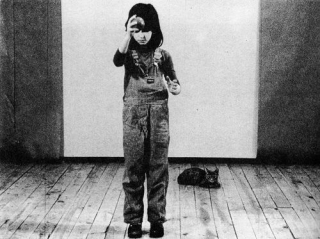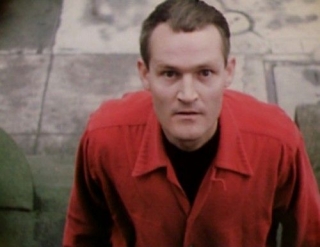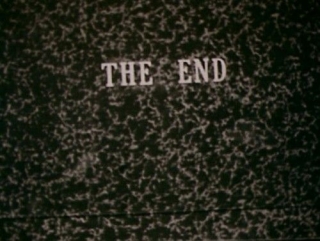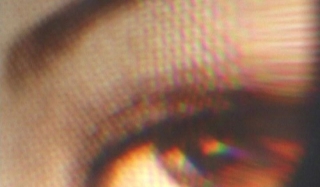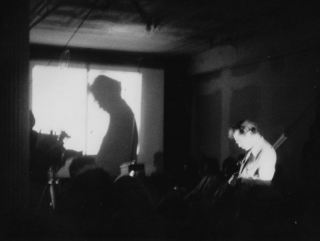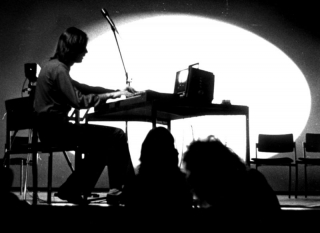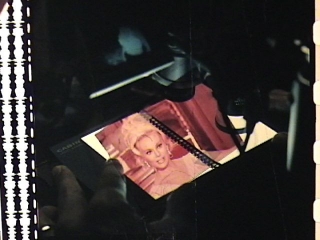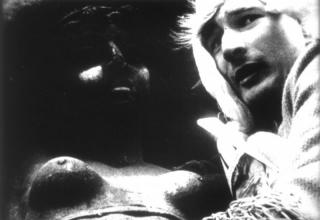Date: 30 July 2003 | Season: Miscellaneous
AN EVENING WITH YVONNE RAINER
Wednesday 30 July 2003, at 7pm
London Whitechapel Gallery
Yvonne Rainer will introduce a screening of her first feature film Lives of Performers, followed by a discussion between Yvonne Rainer, Berlin-based writer / curator Madeleine Bernstorff and the audience.
Yvonne Rainer, Lives of Performers, USA, 1972, 16mm, b/w, sound, 90 min
Explicating the emotional love triangle between three dancers who, as characters, play themselves, Lives of Performers is at once a melodrama and a sustained documentation of roles played within roles. Simultaneously stylised and asymmetrical, posed and improvised, it beats an episodic path through public and private observation (the dancers in rehearsal, backstage and onstage), love and pain, possibility and impasse, culminating in a series of tableaux that tell the Lulu story. Babette Mangolt’s camerawork echoes Rainer’s choreography, describing emotional intensity through durational experience, challenging narrative conventions and reconstructing expectation as radical experience.
Presented by LUX, Mary Kelly Project and Whitechapel, in association with the London International Summer School.
Date: 30 September 2003 | Season: Christopher Maclaine
HERE ARE SOME PICTURES, WHAT IS HAPPENING? CHRISTOPHER MACLAINE & THE SAN FRANCISCO UNDERGROUND
30 September—7 October 2003
London The Other Cinema
The ‘beat generation’ were born in the depression, raised during World War II and matured in the ominous shadow of the Atomic bomb. Their spontaneous, creative reaction against the mainstream was a primitive howl for freedom. Beaten and downtrodden, beatific and elevated, rhythmic and vital like the beat of the drum.
Christopher Maclaine was active in the early hipster scene of San Francisco’s North Beach in the 1940s-1950s, one of the authentic characters at the very emergence of the beat movement. He contributed poetry and prose to small periodicals with his contemporaries Michael McClure, Robert Duncan, Kenneth Patchen and Philip Lamantia, and read at late night rap sessions in coffee bars and jazz clubs. His introduction to avant-garde world came through exposure to the important “Art in Cinema” series at San Francisco Museum of Art, and personal connections with pioneer filmmakers Jordan Belson, Stan Brakhage, Larry Jordan and Harry Smith.
He was often completely broke, unable to keep jobs, and constantly relying on the generosity of others, whose patience he tested. Maclaine was a heavy user of amphetamines, which ultimately rendered him debilitated, resulting in his internment in hospital and early death. From the late 50s he was addicted to methadrine, and in 1963 he attempted suicide, resulting in a three-month stay in the psychiatric ward of SF General Hospital. He died in 1975, having spent his last six years in a completely incapacitated state in a convalescent home.
And now, for the first time in Europe, LUX proudly present these newly restored prints of the complete films of Christopher MacLaine, including his 1953 masterpiece The End. These two screenings at The OTHER Cinema are a unique opportunity to discover a long forgotten visionary filmmaker, together with other documents and masterpieces from the San Francisco beatnik underground, including films by Kenneth Anger and Stan Brakhage.
CHRISTOPHER MACLAINE
HERE ARE SOME PICTURES, WHAT IS HAPPENING? CHRISTOPHER MACLAINE & THE SAN FRANCISCO UNDERGROUND
30 September—7 October 2003
London The Other Cinema
CHRISTOPHER MACLAINE
Poet / Writer / Filmmaker. Born 1923, Wapunucha, Oklahoma. Died 1975, San Francisco, California.
Christopher Maclaine was active in the early beatnik scene of North Beach in the 1940s and 1950s, as one of the authentic characters at the very emergence of the beat movement. He contributed to small periodicals along with his contemporaries Michael McClure, Robert Duncan, Kenneth Patchen and Philip Lamantia, and read poetry at late night rap sessions in coffee bars and jazz clubs. His introduction to the avant-garde film world came through exposure to the important “Art in Cinema” series at San Francisco Museum of Art, and personal connections with pioneer filmmakers Jordan Belson, Stan Brakhage, Larry Jordan and Harry Smith.
He was often completely broke, unable to keep jobs, and constantly relying on the generosity of others, whose patience he tested. Maclaine was a heavy user of amphetamines, which ultimately rendered him debilitated, resulting in his internment in hospital and early death. From the late 1950s he was addicted to methadrine, and in 1963 he attempted suicide, resulting in a three-month stay in the psychiatric ward of San Francisco General Hospital. He died in 1975, having spent his last six years in a completely incapacitated state in a convalescent home.
Maclaine edited four issues of the small magazine Contour (1947-49) and contributed to journals such as Neurotica, Tiger’s Eye, Beautitude, Goad and Golden Goose. He published three books of his own writing: The Automatic Wound (1948), The Crazy Bird (1951) and The Time Capsule (1960).
Maclaine made only four films, which until now have been rarely shown and are little known beyond a small circle of admirers. The films were brought into circulation in the mid-1960s by Stan Brakhage, who had encountered Maclaine in San Francisco in the 1950s. LUX has recently purchased brand new prints of the complete films of this obscure and mysterious Californian beat poet and hopes that they will now gain a new and appreciative audience.
Back to top
Date: 30 September 2003 | Season: Christopher Maclaine
THE FILMS OF CHRISTOPHER MACLAINE
Tuesday 30 September 2003, at 7pm
London The Other Cinema
Jazz, dope and rebellion – four films from the hipster subculture of San Francisco, all made by obscure and elusive poet Christopher Maclaine. His masterpiece The End (1953), salvaged in the 60s by Stan Brakhage and revered by many since, is a remarkably apocalyptic post-war saga of impending doom: the last day on earth for six of ‘our friends’ living in the shadow of the A-bomb. These new prints of Maclaine’s complete films also feature alchemical incantation (The Man Who Invented Gold), existential despondence (Beat) and highland flings (Scotch Hop).
Christopher Maclaine, The End, 1953, colour, sound, 35 min
Christopher Maclaine, Beat, 1958, colour, sound, 6 min
Christopher Maclaine, The Man Who Invented Gold, 1957, colour, sound, 14 min
Christopher Maclaine, Scotch Hop, 1959, colour, sound, 6 min
PROGRAMME NOTES
THE FILMS OF CHRISTOPHER MACLAINE
Tuesday 30 September 2003, at 7pm
London The Other Cinema
THE END
Christopher Maclaine, 1953, b/w & colour, sound, 35m
Narrated by Christopher Maclaine. Photographed by Jordan Belson.
The End is a remarkable apocalyptic post-war saga of impending doom, which follows the last day on earth for six of ‘our friends’ living in the shadow of the A-bomb. Composed of six discreet episodes, the film builds an atmosphere of doom, infused with what seems now to be dark, ironic humour. Maclaine’s virtuoso, past-tense narration is a bewildering and incoherent rant against the impending holocaust, directly addressing the viewer, who is forced to become and active participant in the story. His fractured montage works against narrative logic, a self-destructive trait that mirrors the ‘grand suicide of the human race’.
The End is partly acted, with additional observational footage. These fleeting glimpses of the world around show normal lives continuing oblivious to the nuclear threat. Disjointed cutting, subverted narratives and cryptic camerawork fuse banality with purpose. This is a truly poetic use of cinema in the way it is able to transmit unspoken thoughts through an apparently random successions of images.
Dating from 1953, this may in fact be the first genuine ‘beat’ film, profoundly inventive and advanced for its time. Maclaine’s outlook is bleak and his techniques are crude, creating a film which is deliciously inept, but glorious. One of cinema’s starkest evocations of the Cold War period and its effect on creative thought, situated in the beat milieu of 1950s San Francisco but speaking in direct terms to generations of lost souls.
BEAT
Christopher Maclaine, 1958, colour, sound, 6m
A visual notebook which captures the existential angst and futility of bohemian life, evoking the despondent mood of a particular moment in American culture. The film is an abstract hide-and-seek featuring a man and woman wandering separately through the parks and streets of 1950s San Francisco. Perhaps they are escaping from their impoverished lives in search of freedom and enlightenment. She performs an invocation at an intersection and is later liberated, while he, less wilful, ends up losing his marbles at the beach.
THE MAN WHO INVENTED GOLD
Christopher Maclaine, 1957, b/w & colour, sound, 14m
Narrated by Christopher Maclaine. Photographed by Jordan Belson. Music by Christopher Maclaine and George Abend. Recorded by R.W. Emerson.
A demented fable of alchemical inquisition. Ridiculed by his neighbours, a madman works in isolation on a chemical formula for making gold. He finally succeeds after being told the secret in a dream, but his conceit drives him to get back at his sceptical friends, turning one neighbour into gold before he is punished by being turned to gold himself. Maclaine takes the central role, though many others (including filmmaker Larry Jordan) act as stand-ins throughout. The substitution of people is one of the metaphors representing the transformations in the story. The images are a complex mix of not only positive and negative black-and-white and colour stock, but also live action with abstract, scratched and hand-painted sections, while Maclaine’s rambling narration is an allegorical nonsense poem.
SCOTCH HOP
Christopher Maclaine, 1959, colour, sound, 6m
In acknowledgement of his Scottish heritage, Maclaine photographed this cine-poem to document an authentic highland gathering in the town of Petaluma, California. The pastimes include speed walking, tossing the caber, traditional dances, bagpipe and drum troops. Using unlikely camera angles and tight, rhythmic cutting, Maclaine performs an impromptu dance with the camera, cut to the tuneful droning of the pipes and drums. You can take the Maclaines out of Scotland, but you can’t take Scotland from the Maclaines.
All texts by Mark Webber, 2003
Back to top
Date: 7 October 2003 | Season: Christopher Maclaine
TO RE-EDIT THE WORLD
Tuesday 7 October 2003, at 7pm
London The Other Cinema
A chance encounter with Loreon Vigné, at the Temple of Isis in California, started David Sherman on a mysterious journey through the outer reaches of 50s & 60s bohemia. Loreon’s memories, and the films of her deceased husband Dion, told of their orbit around an artistic circle that included Kenneth Anger, Jordan Belson, Christopher Maclaine and the Whitney Brothers, and intersections with the occult (Bobby Beausoleil, Anton LaVey). This loose video documentary includes evocative footage and audio recordings of the era. Screening with classic films of that period, including Kenneth Anger’s Inauguration of the Pleasure Dome, Stan Brakhage’s Desistfilm and Moods in Motion, a newly discovered abstract film with soundtrack by Christopher Maclaine.
David Sherman, To Re-Edit the World, 2003, colour, sound, 32 min
Ettillie Wallace, Moods in Motion, c.1950s, colour, sound, 5 min
Stan Brakhage, Desistfilm, 1954, b/w, sound, 7 min
Kenneth Anger, Inauguration of the Pleasure Dome, 1954/66, colour, sound, 38 min
Date: 8 October 2003 | Season: LUX Salon
LUX SALON: WOJCIECH BRUSZEWSKI: FILM / VIDEO / PHENOMENA
Wednesday 8 October 2003, at 7:30pm
London LUX
As a founder member of the Lodz Film Academy’s radical Workshop of Film Form in the early 70s, Wojciech Bruszewski’s multimedia experiments included YYAA, a 3-minute long primal scream in which changes in light exposure modulate the soundtrack. Other films, like Tea-Spoon and Match-Box, also challenged the viewer by manipulating expectations of synchronous sound and image, and his early video work examines the immediate relationship between camera, monitor and viewer made possible by instant playback or live feed technology. At the LUX Salon, Bruszewski will offer a selection of works by himself and his students, from his earliest days to the present. The final programme contents to be decided by the audience on the night.
Presented in association with Lumen and Evolution 03, Leeds.
Date: 10 October 2003 | Season: Evolution 2003
WOJCIECH BRUSZEWSKI: FILM / VIDEO / PHENOMENA
Friday 10 October 2003, at 4pm
Leeds Evolution 03 at the Leeds College of Music
Wojciech Bruszewski is one of Poland’s foremost media artists, active in the fields of theory and practice, who uses film, video, photography, computers and language to create audio-visual works and installations that frequently examine the phenomena of sight and perception.
Bruszewski was a student at the National Film Academy in Lodz, a city with a strong avant-garde history (particularly in Constructivism), and home to the only Polish museum of modern art. Here, he connected with other radical artists and, with Józef Robakowski, Zbigniew Rybczynski and Ryszard Wasko, formed the Workshop of Film Form, which conducted multimedia experiments throughout the early 1970s.
Bruszewski’s film and video works are effectively analytical investigations into the specific properties of each medium. His best-known film work is YYAA, in which changes in light exposure direct the soundtrack that is created by editing together a 3-minute long primal scream. Other works, like Tea-Spoon and Match-Box, also challenge the viewer by manipulating our expectations of synchronous sound and image. Much of Bruszewski’s early work in video examines the immediate relationship between camera, monitor and viewer made possible by instant playback or live feed technology.
The artist will be present to discuss the theories behind his works and screen examples of his pioneering films, videos and documentation of installations, plus the film performance Points.
Wojciech Brusezewski was born in 1947 in Wroclaw, Poland. Lives and works in Lodz, Poland. A practising artist and theorist since 1967. Founder of the WARSZTAT Group of avant-garde filmmakers 1970-76, made the first Polish art videotape in 1972. Exhibited at Documenta 6 & 8, Hayward Gallery, Centre Pompidou, Kölnischer Kunstverein Sydney Biennial, awarded DAAD residency in 1980. Associate Professor at Art Academy, Poznan and Nicholas Copernicus University, Torun.
Date: 13 October 2003 | Season: LUX Salon
LUX SALON: TAKA IIMURA: 2 FILM PERFORMANCES
Monday 13 October 2003, at 7:30pm
London LUX
Legendary Japanese avant-garde film and video artist Takahiko Iimura has rigorously explored structural, material and theoretical properties of film, video and new media for over 40 years. At the Lux Salon he will appear in person to present two of his vintage live film performance of the 1970s: Circle and Square (for 16mm film loop and hole punch) and White Calligraphy (for mobile Super-8 projector).
Presented in association with Lumen and Evolution 03, Leeds.
Date: 15 October 2003 | Season: Miscellaneous
THE FUTURE IS NOT WHAT IT USED TO BE
15 October—22 November 2003
UK Tour
Three films by Mika Taanila, including his new documentary on the pioneering Finnish electronic music and cybernetic artist Erkki Kurenniemi, who began to build computer instruments in the 1960s. More recently, he has become manically preoccupied with achieving immortality by documenting his every thought and movement. Also screening: Futuro, about the flying-saucer shaped plastic house created by visionary architect Matti Suuronen, and A Physical Ring, a kinetic found-footage film with music by Mika Vainio of Pan Sonic.
Mika Taanila, Futuro: A New Stance for Tomorrow, Finland, 1998, 30 min
Mika Taanila, A Physical Ring, Finland, 2002, 4 min
Mika Taanila, The Future is Not What it Used to Be, Finland, 2002, 52 min
Mika Taanila will introduce the screening and answer audience questions on 16 October. Advance booking is recommended. Presented by LUX in association with The Finnish Institute and The Wire.
Wednesday 15 October 2003 (UK Premiere)
SHEFFIELD International Documentary Film Festival
Thursday 16 October 2003 [repeated Tuesday 28 October 2003]
LONDON The Other Cinema
Saturday 18 October 2003
GLASGOW CCA
Sunday 19 October 2003
BRIGHTON Cinematheque
Wednesday 22 October 2003
DUBLIN Electronic Arts Festival
Tuesday 28 October 2003
CANTERBURY Kent Institute of Art & Design
Thursday 6 November 2003
NEWCASTLE Cineside
Saturday 22 November 2003
BIRMINGHAM MAC
Mika Taanila (born 1965) has studied cultural anthropology at Helsinki University and graduated from Lahti Institute of Design, video department in 1992. Lives and works in Helsinki as free film director and video teacher at Academy of Fine Arts. Producer of new media arts in the Promotion Centre for Audiovisual Culture in Finland. Mika is a member of Team Avanto, organisers of Helsinki’s Avanto Festival of electronic arts and media.
PROGRAMME NOTES
FUTURO – A NEW STANCE FOR TOMORROW
Mika Taanila, Finland, 1998, colour, sound, 30 min
In 1968, the Finnish architect Matti Suuronen designed Futuro, a house made of plastic, which resembles a flying saucer and reflects the 1960s optimism of space travel. It was another classic of Finnish design alongside the famous ball-shaped “globe chairs” by Eero Aarnio. This film chronicles the rise and fall of Futuro during the 1970s oil crisis, which rendered the commercial manufacture of the plastic house nearly impossible. A journey back in time to our recent futuristic past, and the story of a Space Age utopia that almost came true.
A PHYSICAL RING
Mika Taanila, Finland, 2002, colour, sound, 4 min
A minimal found-footage film based on material from an anonymous Finnish physical test that took place in the 1940’s. The original purpose of the test remains unknown today. Through careful editing, inanimate research footage is assembled to a piece of kinetic fantasy. An integral part of the final work is the specially commissioned, haunting soundtrack by Ø (Mika Vainio of Pan Sonic).
FUTURE IS NOT WHAT IT USED TO BE
Mika Taanila, Finland, 2002, colour, sound, 52 min
A film about Erkki Kurenniemi, the human memory, computers and immortality. Kurenniemi is a forgotten visionary and pioneering figure in the history of Finnish avant-garde film and music, whose career represents a surprisingly natural blend of music, film, computers, robotics, science and art. He composed computer-based music and designed his own electronic instruments as early as the 1960s. His project of collecting everything around him will perhaps be the most significant of all his works. Kurenniemi records his thoughts, observations, objects and images constantly, with manic precision, with the ultimate goal of merging man and machine – reconstructing the human soul. The film looks into the past, but very clearly sees far ahead into the future through it.
Back to top
Date: 26 October 2003 | Season: London Film Festival 2003 | Tags: London Film Festival
THE TIMES BFI 47th LONDON FILM FESTIVAL
22 October – 6 November 2003
London National Film Theatre
This year, the majority of the avant-garde programmes will be focused around the weekend of 1 & 2 November. The Experimenta “Avant-Garde Weekend” is a unique opportunity to survey some of the most vital films and videos made around the world in recent years, and our only annual chance to do so on such a scale in England. All the mixed programmes plus selected features will be shown over the two-day period, and several of the filmmakers will be present to discuss their work. This concentrated period of screenings will hopefully encourage the film/video community to gather together.
Three mixed programmes of new international short films feature works by Louise Bourque, Nathaniel Dorsky, Lewis Klahr, Guy Sherwin and Phil Solomon, “Video Visions” showcases recent tapes by artists including George Kuchar, Jeroen Offerman and Michaela Schwentner, and a new video by John Smith plays with two stunning collage works by Michele Smith (no relation), who is showing in the UK for the first time (as are many others). There are also documentaries on Jonas Mekas and Amos Vogel, two pioneering promoters of artists’ filmmaking.
The weekend before that, on Sunday 26 October legendary New York filmmaker Ken Jacobs returns to the LFF with his recently completed 6-hour video “Star Spangled To Death”, which has been a work-in-progress since 1957. Distinguished Professor Jacobs will also present a lecture on “failure” the day after the screening. The Experimenta section of the festival also includes new feature length works by Mike Hoolboom, Guy Maddin, Pat O’Neill, Wang Bing and much more.
Date: 26 October 2003 | Season: London Film Festival 2003 | Tags: London Film Festival
STAR SPANGLED TO DEATH
Sunday 26 October 2003, at 2pm
London National Film Theatre NFT3
‘Despair is collaboration with the enemy.’ (Ken Jacobs)
Ken Jacobs, Star Spangled To Death, USA, 1957-2003, 375 min`
The Spirit Not Of Life But Of Living (Jack Smith) floats and stumbles through the world, delighting in action for its own sake. Suffering (Jerry Sims) upsets the cosmic balance by finding happiness in the consolation of his dolls. To restore order, the dolls are seized by The Two Evils, only to be returned by Misplaced Charity, plunging screen and viewers into Limbo.
The realisation of Star Spangled To Death as a 6-hour long video concludes a work begun by filmmaker Ken Jacobs almost a half century ago. In this final version, which closely follows the original plans, long passages from public information films, cartoons, documentaries and musicals (often shown in their entirety) are interspersed by (and in tension with) Jacobs’ own footage, which was shot mostly in late-50s New York and testifies to the birth of a new cinema: liberated and spontaneous, absurd yet real, with zest and meaning. Those were different times and the participants then young and innocent (many have since died). But change a few names and faces, and the subject matter becomes remarkably Present. Touching upon politics, war, race, religion and science, it is not a curio or period piece, but an ongoing commentary on the country that made it possible. An indictment, or at the least a parable, of the USA in the modern world: a juggernaut careening to certain destruction.
Richard Nixon’s incredible 1952 tv disclosure butts up against a documentary on the emotional responses of mother-deprived lab monkeys, song and dance routines and ‘educational’ dramas for young black adults. Star Spangled To Death is a Saturday morning picture show of a movie, its length ‘a perverse reach for the intolerable’. It will make you laugh, it will make you cry. ‘Are ya havin’ any fun?’ —Mark Webber
Star Spangled to Death will be shown in two parts with 60-minute intermission.
Back to top
